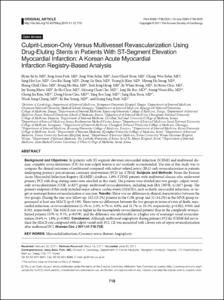KUMEL Repository
1. Journal Papers (연구논문)
1. School of Medicine (의과대학)
Dept. of Internal Medicine (내과학)
Culprit-Lesion-Only Versus Multivessel Revascularization Using Drug-Eluting Stents in Patients With ST-Segment Elevation Myocardial Infarction: A Korean Acute Myocardial Infarction Registry-Based Analysis
- Keimyung Author(s)
- Hur, Seung Ho
- Department
- Dept. of Internal Medicine (내과학)
- Journal Title
- Korean Circulation Journal
- Issued Date
- 2011
- Volume
- 41
- Issue
- 12
- Abstract
- Background and Objectives: In patients with ST-segment elevation myocardial infarction (STEMI) and multivessel disease, complete revascularization (CR) for non-culprit lesions is not routinely recommended. The aim of this study was to compare the clinical outcomes of multivessel compared with infarct-related artery (IRA)-only revascularization in patients undergoing primary percutaneous coronary intervention (PCI) for STEMI. Subjects and Methods: From the Korean Acute Myocardial Infarction Registry (KAMIR) database, 1,094 STEMI patients with multivessel disease who underwent primary PCI with drug-eluting stents were enrolled in this study. The patients were divided into two groups: culprit-vessel-only revascularization (COR, n=827) group; multivessel revascularization, including non-IRA (MVR, n=267) group. The primary endpoint of this study included major adverse cardiac events (MACEs), such as death, myocardial infarction, or target or nontarget lesion revascularization at one year. Results: There was no difference in clinical characteristics between the two groups. During the one-year follow-up, 102 (15.2%) patients in the COR group and 32 (14.2%) in the MVR group experienced at least one MACE (p=0.330). There were no differences between the two groups in terms of rates of death, myocardial infarction, or revascularization (2.1% vs. 2.0%, 0.7% vs. 0.8%, and 11.7% vs. 10.1%, respectively; p=0.822, 0.910, and 0.301, respectively). The MACE rate was higher in the incompletely revascularized patients than in the completely revascularized patients (15% vs. 9.5%, p=0.039), and the difference was attributable to a higher rate of nontarget vessel revascularization (8.6% vs. 1.8%, p=0.002). Conclusion: Although multivessel angioplasty during primary PCI for STEMI did not reduce the MACE rate compared with culprit-vessel-only PCI, CR was associated with a lower rate of repeat revascularization after multivessel PCI.
- Keimyung Author(s)(Kor)
- 허승호
- Publisher
- School of Medicine
- Citation
- Hyun Su Jo et al. (2011). Culprit-Lesion-Only Versus Multivessel Revascularization Using Drug-Eluting Stents in Patients With ST-Segment Elevation Myocardial Infarction: A Korean Acute Myocardial Infarction Registry-Based Analysis. Korean Circulation Journal, 41(12), 718–725. doi: 10.4070/kcj.2011.41.12.718
- Type
- Article
- ISSN
- 1738-5520
- Appears in Collections:
- 1. School of Medicine (의과대학) > Dept. of Internal Medicine (내과학)
- 파일 목록
-
-
Download
 oak-aaa-03285.pdf
기타 데이터 / 513.79 kB / Adobe PDF
oak-aaa-03285.pdf
기타 데이터 / 513.79 kB / Adobe PDF
-
Items in Repository are protected by copyright, with all rights reserved, unless otherwise indicated.